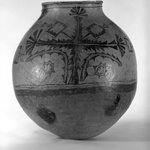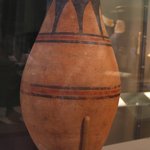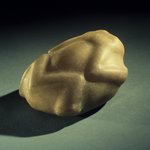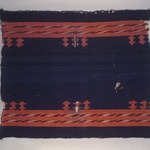
Water Jar
Arts of the Americas
A woman probably made this delightful water jar, since all pottery was done by women during the nineteenth century. The jar was created in a traditional manner: clays dug locally from around Zuni Pueblo were hand-kneaded with old sherds worked into the clay as temper, coiled into shape, and smoothed; mineral paints and slips were applied, and then the vessel was fired within an open fire. Scholars refer to this full-bodied style as Kiapa Polychrome, a style between the earlier polychrome jars that have low bulges in their bodies and a later style that has a high shoulder bulge. The butterfly was one of several motifs favored by Zuni artists. Others were water symbols such as tadpoles and frogs, deer with a heart-line motif, and hunting animals. The early curator Stewart Culin collected this vessel from Andrew Vanderwagon, the owner of the Zuni trading post where Culin stayed when he was collecting in 1903. Today Zuni pottery is still made in the traditional manner, although some potters are men and some use an electric kiln to add consistency to the firing.
CULTURE
A:shiwi (Zuni Pueblo)
MEDIUM
Clay, pigment
DATES
1825–1850
DIMENSIONS
12 3/4 x 12 3/4 in. (31.5 x 33.5 cm) (show scale)



COLLECTIONS
Arts of the Americas
ACCESSION NUMBER
03.325.4723
CREDIT LINE
Museum Expedition 1903, Museum Collection Fund
PROVENANCE
Prior to 1903, provenance not yet documented; by 1903, acquired by Andrew Vanderwagen of Zuni, NM; 1903, purchased in Zuni by Stewart Culin for the Brooklyn Museum.
Provenance FAQ
CATALOGUE DESCRIPTION
Jar, black on white exterior. This oversize water jar has a butterfly design, a symbol often associated with water, set within a large, continuous stepped figure on the body. The neck design consists of a continuous stepped band with curled figures attached. In use it would have a piece of hide stretched and tied across the top, thus accounting for the rough edges on the jar. Red writing on base reads "03.325.4723" and "03.132," partial number is written in black on the side.
Condition: Small hole in base, worn rim
MUSEUM LOCATION
This item is not on view
CAPTION
A:shiwi (Zuni Pueblo). Water Jar, 1825–1850. Clay, pigment, 12 3/4 x 12 3/4 in. (31.5 x 33.5 cm). Brooklyn Museum, Museum Expedition 1903, Museum Collection Fund, 03.325.4723. Creative Commons-BY (Photo: Brooklyn Museum, 03.325.4723_PS22.jpg)
IMAGE
overall, 03.325.4723_PS22.jpg. Brooklyn Museum photograph, 2024
"CUR" at the beginning of an image file name means that the image was created by a curatorial staff member. These study images may be digital point-and-shoot photographs, when we don\'t yet have high-quality studio photography, or they may be scans of older negatives, slides, or photographic prints, providing historical documentation of the object.
RIGHTS STATEMENT
Creative Commons-BY
You may download and use Brooklyn Museum images of this three-dimensional work in accordance with a Creative Commons license. Fair use, as understood under the United States Copyright Act, may also apply.
Please include caption information from this page and credit the Brooklyn Museum. If you need a high resolution file, please fill out our online application form (charges apply).
For further information about copyright, we recommend resources at the United States Library of Congress, Cornell University, Copyright and Cultural Institutions: Guidelines for U.S. Libraries, Archives, and Museums, and Copyright Watch.
For more information about the Museum's rights project, including how rights types are assigned, please see our blog posts on copyright.
If you have any information regarding this work and rights to it, please contact copyright@brooklynmuseum.org.
RECORD COMPLETENESS
Not every record you will find here is complete. More information is available for some works than for others, and some entries have been updated more recently. Records are frequently reviewed and revised, and we welcome any additional information you might have.





































![Kachina Doll (Pakwen [Clown])](https://d1lfxha3ugu3d4.cloudfront.net/images/opencollection/objects/size2_sq/CUR.03.325.4606_front.jpg)











